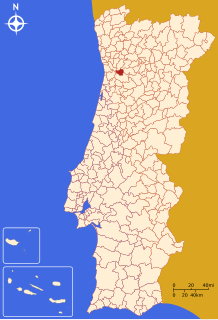Castelo de Paiva | |
|---|---|
 | |
| Coordinates: 41°04′N 8°15′W / 41.067°N 8.250°W | |
| Country | |
| Region | Norte |
| Intermunic. comm. | Tâmega e Sousa |
| District | Aveiro |
| Parishes | 6 |
| Government | |
| • President | Gonçalo Rocha (PS) |
| Area | |
| • Total | 115.01 km2 (44.41 sq mi) |
| Population (2011) | |
| • Total | 16,733 |
| • Density | 150/km2 (380/sq mi) |
| Time zone | UTC±00:00 (WET) |
| • Summer (DST) | UTC+01:00 (WEST) |
| Website | http://www.cm-castelo-paiva.pt/ |
Castelo de Paiva (Portuguese pronunciation: [kɐʃˈtɛlu ðɨ ˈpajvɐ] ) is a town and a municipality of the Aveiro District in Portugal. The population in 2011 was 16,733,[1] in an area of 115.01 km2.[2]
On 4 March 2001 at 9 pm, a 116-year-old metal bridge linking the parish/council of Sobrado (a.k.a. Castelo de Paiva) and Entre-os-Rios (a bridge connecting Castelo de Paiva to Penafiel) collapsed, killing 59 people, including those in a bus from the Asadouro company and three cars that were attempting to get to the other side of the Douro river.[3] The Hintze Ribeiro Bridge disaster prompted accusations of government negligence, and the Public Works minister Jorge Coelho resigned shortly after the disaster. There is a monument near the bridge in honour of the people who died, known as the "Anjo de Portugal" (The Angel of Portugal).
The Mayor is Gonçalo Rocha, elected by the Socialist Party (PS). His term goes until 2021.
The municipal holiday is 24 June, Saint John's day.

- ^ Instituto Nacional de Estatística
- ^ "Áreas das freguesias, concelhos, distritos e país". Archived from the original on 2018-11-05. Retrieved 2018-11-05.
- ^ Entre-os-Rios: Seis técnicos na barra do tribunal amanhã Archived 2012-02-10 at the Wayback Machine in Diário Digital, April 18, 2006

